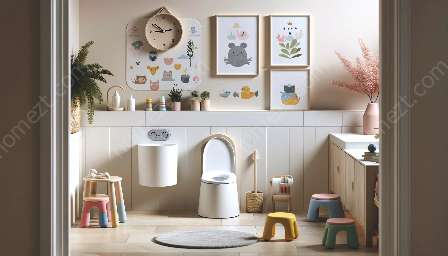Potty training is an essential milestone for children, and establishing a potty routine is crucial in this process. By creating a consistent and engaging routine, you can help your child develop healthy bathroom habits. This topic cluster will explore the best practices for establishing a potty routine and how to make it fun and effective, while incorporating it into your nursery and playroom.
Understanding Potty Training
Potty training is the process of teaching a child to use the toilet for urination and defecation. Every child's readiness for potty training is different, so it's important to watch for signs that your child is ready, such as staying dry for longer periods, showing interest in using the toilet, or the ability to follow simple instructions.
Benefits of Having a Potty Routine
Establishing a potty routine provides several benefits for both the child and the parent. It helps the child develop a sense of control and independence, promotes good hygiene, and reduces the reliance on diapers. For parents, a potty routine reduces the workload of changing diapers and saves money on diaper expenses.
Key Strategies for Establishing a Potty Routine
1. Consistency: Consistency is key when it comes to potty training. Create a consistent schedule for potty breaks, such as after meals, before bedtime, and upon waking up.
2. Positive Reinforcement: Encouragement and praise are powerful motivators for children. Celebrate successes and provide rewards for using the potty, such as stickers or small treats.
3. Communication: Clear communication is essential. Use simple language to explain the purpose of using the toilet and encourage your child to communicate their needs when they need to go.
4. Role Modeling: Children learn by example, so consider allowing them to observe older siblings or adults using the toilet.
Making the Routine Fun and Engaging
Transforming the potty routine into an enjoyable experience can make the process more successful. Consider decorating the bathroom with your child's favorite characters, providing colorful and engaging potty training books, or using a musical potty chair to make it more entertaining.
Incorporating the Routine into the Nursery and Playroom
1. Potty Training Station: Set up a dedicated potty training station in the nursery or playroom, equipped with a child-friendly potty seat, step stool, and cleansing wipes for easy access.
2. Positive Reinforcement Charts: Create a visual chart in the playroom to track your child's progress with potty training. Allow them to add stickers or stars for each successful trip to the potty.
Final Thoughts
Establishing a potty routine requires patience, consistency, and a positive attitude. By incorporating these strategies and making the routine fun and engaging, you can support your child's transition from diapers to using the toilet independently. Embracing this milestone with creativity and encouragement can make the potty training process a rewarding experience for both you and your child.


